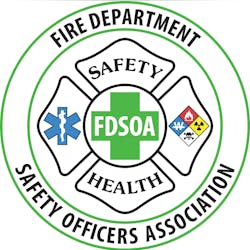SCOTTSDALE, Ariz. – In a freewheeling roundtable-type discussion with a variety of apparatus experts, attendees of the Fire Department Safety Officers Association's (FDSOA) 28th annual Apparatus Symposium covered everything from seat belt lengths to diesel emission to crashes.
The panelists for the hour-long discussion included Bill Metcalf, a former International Association of Fire Chiefs president, Jason Witmier, Aerial Product Manager for KME Fire Apparatus, Tom Shand, a partner with Emergency Vehicle Response and a 40-year fire service veteran and Mike Wilbur who is also a partner with Emergency Vehicle Response and a 40-plus year fire service veteran. Both Wilbur and Shand are contributing editors for Firehouse.
Fielding a question related to how does a fire department convince their community about the apparatus needs, Shand took the microphone first.
He said sometimes, an outside, third party expert can be perceived as having more credible answers than the local firefighters and officers.
“Why, because we live 10 miles from you, carry brief cases and people think we know what we’re talking about,” Shand said. He added that good help can help firefighters convince communities’ authorities the need is real.
Witmier said education is key.
“You have to educate the public about what you need,” Witmier said. “You can’t say you need a 100-foot aerial when all you have are two-story houses. You need to be honest and you need to pull out all the stats. …You have to drive home what you have and what you want to buy.”
Metcalf agreed with Witmier and added that the days of the chief being the final authority on what communities need for fire equipment are over.
“It used to be when people said no to the fire chief, the chief would say babies will die, grandma will die and the sky will fall,” Metcalf said. “Then everybody would say; ‘OK, we’ll give you what you want.’ It’s not like that anymore.”
Another question was related to line of duty deaths involving fire apparatus and what can the fire service do to reduce them and one day eliminate them.
Witmier said manufacturers are doing more now than ever to keep firefighters safe with crash testing cabs, rollover protection and prevention technology. Unfortunately, airbags and protection systems are expensive and often deleted, he said.
“They are high dollar and often the first things to go when a committee starts looking at budget,” Witmier said.
Sometimes, customers will ask for too much when it comes to construction in the name of safety, Witmier said noting that KME recently had a department that wanted a front bumper as tough as a tank. That, he said transfers energy from the bumper to the cab and ultimately to the passengers inside, he said adding that fire trucks need to absorb some of the energy during crashes.
“Sometimes, there’s a tendency to make things too beefy,” he said.
Discussion focused for a bit on diesel emissions and whether it would be practical to ask the federal Environmental Protection Agency for an exemption like the military has.
The panelist said it’s more likely the EPA will push the emissions requirements into the military arena rather than letting the fire service off the hook.
Witmier said not only is a federal regulation issue, it’s a corporate issue. With only several thousand apparatus built annually, the market isn’t big enough for engine manufacturers to create special engines for fire apparatus.
One participant noted that the fire service is “just one corporate decision away” from having no engines for fire apparatus.
“The market is too small,” Witmier agreed.
More from FDSOA:
- FDSOA's Apparatus Symposium Opens in Ariz.
- FDSOA Symposium: Diesel Emissions Standards Need not be so Scary
- FDSOA Symposium: NFPA 2015 Apparatus Standards Reviewed
- FDSOA Symposium: Politics Play a Role in Apparatus Purchasing
- FDSOA Symposium: Experts Field Apparatus Questions
- FDSOA Symposium: Detroit FD Weathers City's Bankruptcy
- FDSOA Symposium: Apparatus Design Is Important for ISO Ratings
- FDSOA Symposium: Drones Can Be Valuable Tools For Responders
- FDSOA Symposium: NFPA Focused on Alternative Fuel Emergency Safety
- FDSOA Symposium: Graham Lectures on True Risk Managment
- FDSOA Symposium: Pros and Cons of Thermal Imagers Discussed
- FDSOA Symposium: Maintenance is Key to Keeping Apparatus on the Road






